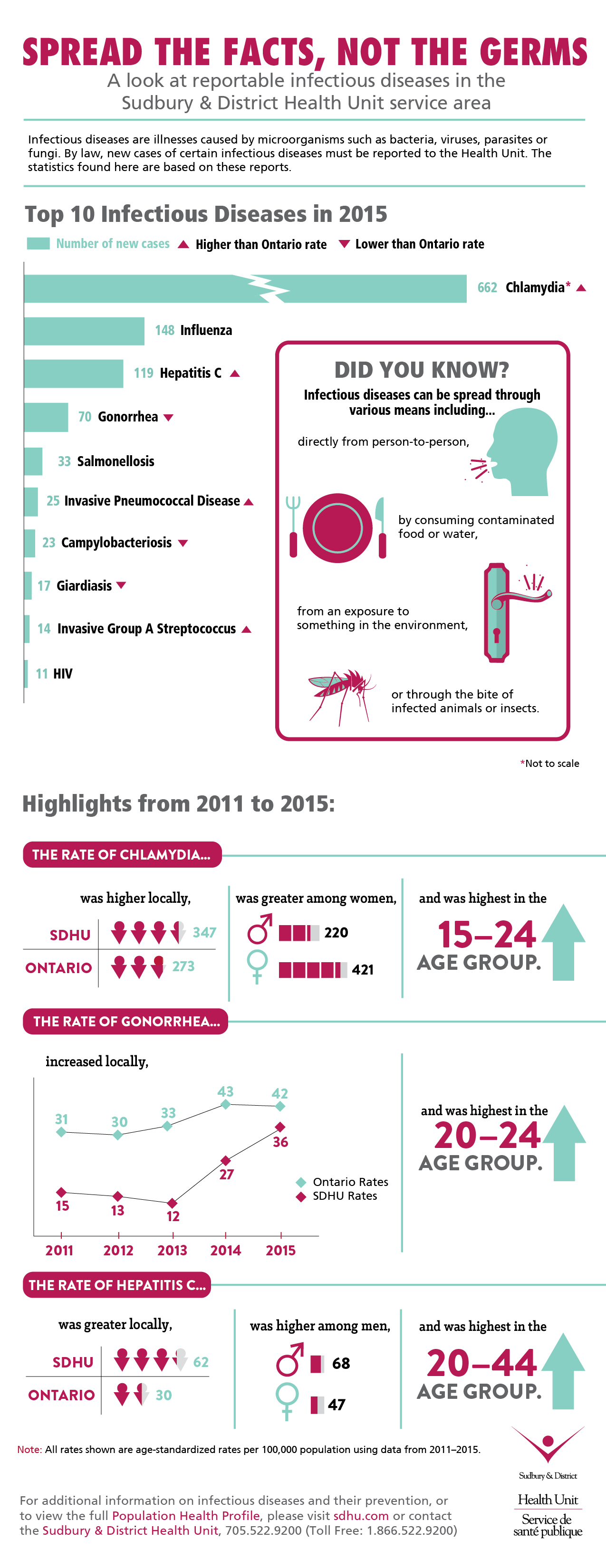Infectious and communicable diseases
Infectious diseases presented in this section of the health profile consists of three main types of illnesses: foodborne, sexually transmitted and bloodborne, and vaccine preventable. Foodborne illnesses are caused by ingesting food or beverages that have been contaminated by microorganisms. Sexually transmitted infections and bloodborne infections (STIs and BBIs) are caused by microorganisms that are spread from person-to-person during sexual contact when body fluids are shared; or through blood or body fluid contact with an infected person. Vaccine-preventable diseases are caused by bacteria and viruses for which effective vaccines are available to prevent illness.
In this report, diseases with an average annual case count of 10 or more are presented in order to allow detailed analysis. All reportable diseases and annual 5-year averages are presented in this table. As a summary of the report, please see our English or French “Infectious Diseases” infographic below.
- Chlamydia
- Influenza
- Hepatitis C
- Gonorrhea
- Salmonellosis
- Invasive Pneumococcal Disease
- Campylobacteriosis
- Giardiasis
- Invasive Group A Streptococcus
- HIV
Infectious Diseases Infographic
Infectious diseases are illnesses caused by microorganisms such as bacteria, viruses, parasites or fungi. By law, new cases of certain infectious diseases must be reported to the Health Unit. The statistics found here are based on these reports.
Aussi disponible en français : Info graphique : Maladies infectieuses
Top ten infectious diseases in the Sudbury & District Health Unit area in 2015:
- There were 662 cases of chlamydia, and the rate was higher than the Ontario rate.
- There were 148 cases of influenza, and the rate was similar to the Ontario rate.
- There were 119 cases of hepatitis C, and the rate was higher than the Ontario rate.
- There were 70 cases of gonorrhea, and the rate was lower than the Ontario rate.
- There were 33 cases of salmonellosis, and the rate was similar to the Ontario rate.
- There were 25 cases of invasive pneumococcal disease, and the rate was higher than the Ontario rate.
- There were 23 cases of campylobacteriosis, and the rate was lower than the Ontario rate.
- There were 17 cases of giardiasis, and the rate was lower than the Ontario rate.
- There were 14 cases of invasive group A streptococcus, and the rate was higher than the Ontario rate.
- There were 11 cases of HIV, and the rate was similar to the Ontario rate.
Did you know?
Infectious diseases can be spread through various means including: directly from person to person, by consuming contaminated food or water, from exposure to something in the environment, or through the bite of infected animals or insect.
During the 2011 to 2015 time period:
Chlamydia
- The rate of chlamydia (347 per 100,000) was higher locally than Ontario (273 per 100,000).
- The rate of chlamydia (421 per 100,000) was higher among women than men (220 per 100,000).
- The rate of chlamydia was highest in the 15 to 24 age group.
Gonorrhea
- The rate of gonorrhea had been increasing at higher rate locally from 2013 to 2015 compared to Ontario.
- The rate of gonorrhea was highest in the 20 to 24 age group.
Hepatitis C
- The rate of hepatitis C (62 per 100,000) was higher locally than Ontario (30 per 100,000).
- The rate of hepatitis C (68 per 100,000) was higher among men than women (47 per 100,000).
- The rate of hepatitis C was highest in the 20 to 44 age group.
This item was last modified on September 14, 2018

